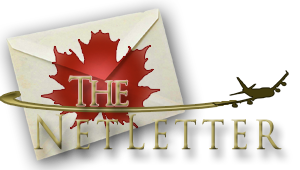|
Terry Baker, co-founder of the NetLetter scours the internet for aviation related Trivia and Travel Tips for you, our readers, to peruse.
At Toronto Pearson, we’re implementing innovative digital solutions to streamline passenger experience.
The Advance CBSA Declaration technology helps returning travellers to expedite customs and immigration; the U.S. Mobile Passport Control App:
www.cbp.gov/travel/us-citizens/mobile-passport-control allows travellers to expedite U.S. customs by submitting personal information in advance of travel.
|
|
Visiting Cancun (CUN).
The VISITAX amount is USD$17 per person, or CAD$22.50 or GBP13.50. Earlier reports suggested scammers were asking tourists to pay up to USD$68 upon arrival. VISITAX agents are now stationed at all terminals at Cancun airport arrivals and departures, located in all airside and landside areas in the airport. They are easily identifiable, and if they approach you, it is MANDATORY TO STOP. Source: travelkore.com |
|
Edmonton, Cooking Lake Airport.
Flashback to 1937 - Inaugural airmail flight to the Yukon The summer of 2024 marked the 87th anniversary of the inaugural airmail flight from Cooking Lake Airport to the Yukon. The flight left Cooking Lake at 0815 on July 5, 1937 and arrived at Dawson City at 1230 on July 7, 1937 to deliver its' cargo of mail and good wishes. The flight made stops at Bear Lake (Grande Prairie), Fort Nelson, Nelson Forks, Lower Post (Hudson Bay Outpost on Liard River), and Whitehorse on its way to Dawson City. For the return trip the flight departed Dawson City at 02:30 on July 8, 1937 with stops in Whitehorse, Lower Post, Fort Nelson, Charlie Lake (near Fort St. John) and arrived back at Cooking Lake at 21:15 after a long day of flying. The aircraft used for the flight was a Ford Trimotor on floats CF-BEP (one of only 3 ever built in a seaplane configuration) and operated by United Air Transport, owned by Grant McConachie. In 1939, CF-BEP was badly damaged in a runway mishap with a Hawker Hurricane at Vancouver. The only part of the aircraft that remains today is a "blow pot" which was used to warm the engine in the winter, and is on display in the Yukon Transportation Museum. In 1995 the Alberta Government transferred ownership of the airport to the Edmonton Airport Authority with the condition that they operate it for at least 10 years.
In 2008, the Edmonton Airport Authority decided Cooking Lake Airport was no longer core to its strategy and began the devolution of the airport. Strathcona County unexpectedly decided not to exercise its right to take over the airport.
To save the airport from closure, a group of volunteers arranged to take over the airport and keep it open to the public. Today, Cooking Lake Airport is the oldest operating public airport in all of Canada, the fifth busiest community airport in Alberta, and one of only 5 CBSA approved international (CANPASS) airports in the province. Source: cookinglakeairport.weebly.com
|
 |

